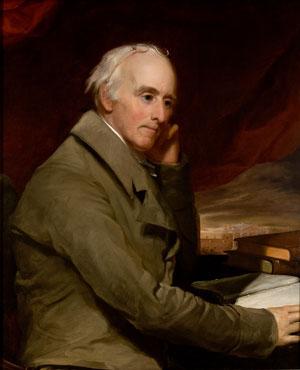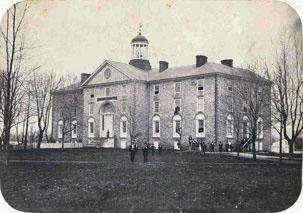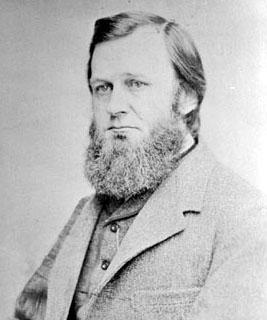"Freedom can exist only in the society of knowledge."
Benjamin Rush

This portrait of Dr. Benjamin Rush by Thomas Sully, known as the greatest American portrait artist of his era, was donated to the college's Trout Gallery.
The Birth of a New College
Revolution was in the air when Benjamin Rush, a prominent Philadelphia physician, prepared the charter for Dickinson College in 1783. A grammar school founded in Carlisle in 1773 served as the foundation of the new college. In the decade prior to laying the groundwork for Dickinson, Rush had marched alongside the American army, signed the Declaration of Independence, served as a physician to the Philadelphia community and maintained his eminent position among the progressive political and intellectual minds of the budding nation. He was a revolutionary in the midst of a revolution.
At his core, Rush believed in freedom—freedom of thought and freedom of action. And he believed fully in America's potential for unprecedented achievement. But Rush also believed that the American Revolution did not end when the muskets stopped sounding; that, he felt, was only the beginning. Now that America had fought for its liberties, Americans needed to maintain a nation worthy of those liberties. Rush knew that America could only live up to its own expectations if it was a country built of an educated citizenry. So seven years after he met with other members of the Continental Congress to add his signature to the Declaration of Independence, Benjamin Rush signed the charter of a new college on what was then the American frontier. On September 9, 1783, a struggling grammar school in Carlisle was transformed into Dickinson College. Less than a week earlier, the Treaty of Paris had officially ended the Revolution and guaranteed international recognition of the United States of America. Dickinson was the first college charted in these new United States.
Tuta libertas. Those were the words that John Dickinson used to describe the new college. Tuta libertas: "A bulwark of liberty." To further his educational enterprise, Rush asked that Dickinson—known widely as the "Penman of the Revolution" and the governor of Pennsylvania—lend his support and his name to the college that was being established in the western frontier of his state. Dickinson was easily convinced, and together he and Rush set about the task of devising a seal for the college. The image they created—featuring a liberty cap, a telescope and an open Bible—remains the official college seal today. It represents a mission that has been ingrained in Dickinson College for more than two centuries: to offer students a useful and progressive education in the arts and sciences—an education grounded in a strong sense of civic duty to become citizen-leaders.
In many ways, Benjamin Rush—the man who set this enduring mission in place—was a man before his time. He was an outspoken opponent of slavery, a vocal proponent of equal education for women, a supporter of the rights of the mentally challenged and a generous provider of health care to the indigent in Philadelphia. His voice was strong and distinctive, and he believed that the students at Dickinson College could, like him, develop their own voices and positions on issues of the day. They could be leaders and shapers in the new nation.
The Shape of the Story
As the site for this endeavor, Rush chose Carlisle, a town founded in 1751 as the seat of Pennsylvania's Cumberland County. Though a center of government, Carlisle was also a frontier town, located about 25 miles west of the Susquehanna River—at the time, an outpost of westward expansion (unlike today, when Carlisle sits at a central transportation crossroad, with Washington, D.C.; Baltimore; and Philadelphia just two hours away). It's safe to assume that this combination of activity and uncertainty would have attracted a man with Rush's educational sensibilities.
From the first, Carlisle was seen as a sort of laboratory for learning—a place, for instance, where Dickinson students could venture from campus to the nearby county courthouse to watch the new American judicial system in action. But it was also a place where, a few decades later, science students could study ecology by actually examining the wilderness of the surrounding Appalachian Mountains. (Dickinson was the first college to introduce field studies into its science curriculum.) These sorts of firsthand experiences, Rush believed, would foster the minds that would lead the next generations of Americans. Time has not diminished Rush's ambitions. Today, this engagement with the wider world continues to guide Dickinson—through internships, field studies, workshop science and one of the most extensive global education programs in the nation.
In 1784, at the first official meeting of the college's trustees in Carlisle, a Scottish minister and educator named Charles Nisbet was elected the first principal, or president, of Dickinson College. Nisbet had been a supporter of the American Revolution and was well known among America's intellectual circles as an impressive man of learning. Sometimes called a "walking library," Nisbet established high standards of education and scholarship for Dickinson students. Because of these unbending expectations, the college can list among its earliest graduates a U.S. president, a pair of college presidents, two justices of the Supreme Court, a governor, a founding father of the Smithsonian Institution and at least two abolitionists.

Old West was designed by Benjamin Latrobe, architect of the United States Capitol.
The Dawn of a New Century
Old West was designed by Benjamin Latrobe, architect of the United States Capitol. As the college grew in population and prominence, Nisbet and the other college leaders decided to construct a new "edifice" to serve as the center of campus—and to allow Dickinson to move out of the old grammar school that had been its home since its founding. Called "New College," the building was constructed slowly, over a period of four years. In 1803, as the college prepared to settle into New College, a blustery snowstorm pushed through the Cumberland Valley, stirring some smoldering ashes in the building's basement. The ashes began to flame, and before long the building had burned to the ground.
Despite the initial despair (Col. John Montgomery, a U.S. Congressman and longtime Dickinson trustee, wrote to inform Rush of the fire, lamenting that all of their hopes "were Blasted in a few minutes"), hints of good fortune soon began to ameliorate the situation. For instance, Benjamin Latrobe, architect of the U.S. Capitol, offered to draw up plans for a new college hall. And private donations from individuals such as Thomas Jefferson and James Madison ensured the reconstruction of Dickinson College in swift fashion. Though Charles Nisbet would not live to see its completion, West College—or Old West, as it's commonly called—hosted its first classes in November 1805.
After his death, Nisbet was remembered as one of the most successful college presidents of his day. It's not surprising, then, that his standards of excellence held strong after his passing. His sensibilities remained integral in the life of the college. In 1812, for example, the college trustees authorized the purchase of Joseph Priestley's scientific equipment, which gave Dickinson state-of-the-art research capabilities in the sciences. (One of the pieces, a lens, is believed to have been used by Priestley in the discovery of oxygen.) It was this dedication to excellence and innovation in education that enticed the world-renowned chemist and social reformer Thomas Cooper to join the faculty as Dickinson's first chemistry professor. Thomas Jefferson, a contemporary, remarked that Cooper was "the greatest man in America in the powers of the mind and in acquired information, and that without exception."
Academic prowess, however, was not necessarily aligned with economic and political prosperity. A combination of financial straits and faculty dissention led to a college closing from 1816 to 1821. Over the period of several years, the trustees managed to overcome both of these hurdles. Barely a decade later, however, strife hit the college again. In the midst of the ongoing financial pressures of the early 19th century, Dickinson's faculty launched into a heated, often bitter, debate about the shape of the college's curriculum. In 1832, when the trustees were unable to resolve the issue, they ordered Dickinson's temporary closure.

Spencer Fullerton Baird, class of 1840, was a professor of natural history and science at the college. He became assistant secretary of the Smithsonian Institute in 1850 and was later promoted to secretary of that institution.
Shortly after doors closed at Dickinson, the Baltimore Conference of the Methodist Episcopal (now United Methodist) Church approached Dickinson’s trustees about reopening as a Methodist-affiliated college. Seeing the opportunity to continue operations, the existing Board of Trustees agreed to dissolve during its June 1833 meeting and handed over the keys to a newly constituted board. On June 7, 1833, the new board elected John Price Durbin as president of the college and chairman of the Board of Trustees.
In 1835, the Baltimore Conference began making an annual contribution to the college, which continues today and helps support the Center for Service, Spirituality & Social Justice .
Under the leadership of John Price Durbin, chaplain of the U.S. Senate, Dickinson College was revitalized. Teaching innovations, like Spencer Fullerton Baird's natural-science field trips (Baird, an alumnus and professor, later helped establish the Smithsonian Institution) and Charles Francis Himes' use of photography to teach chemistry, continued to enhance and distinguish the college's curriculum. Dickinson's law department, which was established in 1833, became the Dickinson School of Law in 1890 (and since 1917 has been independent of the college).
This track record of innovation has continued into Dickinson's modern history—for instance, in the 1980s Dickinson physics professor Priscilla Laws worked with colleagues to develop the widely used "workshop science" curriculum, in which hands-on learning and experimentation (rather than a steady diet of lectures) is at the core of classroom activity. And these innovations know no boundaries. In 1965, for example, Dickinson established a college-run study-abroad program in Bologna, Italy. Since then, Dickinson has sculpted one of the nation's most extensive global education programs, currently consisting of 39 programs in 24 countries on six continents.
Since its early years, the college has emphasized the importance of learning—academically and socially—beyond the classroom. Nineteenth-century students were involved in athletic clubs, social clubs and Greek letter societies. In fact, the first Pennsylvania chapter of Phi Beta Kappa was started at Dickinson in 1886. The college's first Greek fraternity was chartered in 1852. The college's student newspaper, The Dickinsonian, was founded 1872, placing it among the oldest ongoing newspapers in Pennsylvania. And the college's first intercollegiate football game was played against Gettysburg in 1879.
The Growth of a College
During the first half of the 20th century, Dickinson College weathered—with firm resolve—the difficulties posed by World Wars I and II and the Great Depression. Through curricular changes, the faculty found new ways to challenge its students, including one professor who began teaching a course on World War II a year before the United States even entered the conflict—a risky enterprise, considering the national sentiment, led by President Franklin Delano Roosevelt, that America would not get involved in the war. In the midst of the cultural maelstrom, the college trustees found the means to help Dickinson grow, more than doubling the size of the campus and increasing the student enrollment fourfold. During these years of international caution and isolationism, Dickinson developed exchange programs to bring foreign students to Carlisle, and likewise the college began to send Dickinsonians abroad.
In the latter part of the 20th century, Dickinson College continued to enhance its liberal arts curriculum, diversifying traditional disciplines to allow a wide variety of interdisciplinary and area studies opportunities. The college is home, for example, to one of the only community studies centers in the nation, where students can perform field research and take oral histories in local communities from different academic perspectives. Also, Dickinson houses the national headquarters of the Oral History Association and is home to the preeminent study-abroad journal Frontiers.
The college's cross-disciplinary approach has led to strengths in international education, the natural and mathematical sciences, the arts and pre-professional preparation. The curriculum has been further enriched by First-Year Seminars, internships/externships and student-faculty research and publishing. Over the past 10 years, 61 percent of all student-faculty research at Dickinson has resulted in published papers in professional journals, and 28 percent of those findings were presented at national and international conferences.
An Eye on the Past, a Foot in the Future
Proud of its heritage and true to the vision of its founders, Dickinson College remains committed to its historic mission: to prepare young people, by means of a useful and progressive education in the liberal arts and sciences, for engaged lives of citizenship and leadership in the service of society. As it looks toward the future, Dickinson is ever mindful of its revolutionary roots: unafraid to take risks, to speak out on important issues, to remain decisive, competitive and committed to its own brand of the liberal arts—academically rigorous, useful and unapologetically engaged with the world.
Learn more about the history of Dickinson on the Archives & Special Collections website.